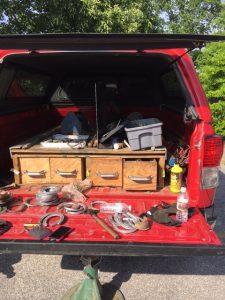Preakness: Hilltop’s ‘Hoof Man’
A Dartmouth green awning shrouded the Preakness horses inside the stakes barn at Pimlico. Only their nameplates were fully visible. D. Wayne Lukas, the legendary trainer, in his trademark white cowboy hat, stood just outside the stable talking to a writer. Jerry Bailey, the celebrated jockey and NBC racing analyst was nearby.
Pimlico visitors on the morning’s last “Sunrise at Old Hilltop” tour—conducted for the past several years during Preakness week—strolled past both men. Then, they took out cell phones to get photos of Preakness long-shot, Calumet Farm’s TERM OF ART, getting a sudsy bucket bath from three groomsmen.
The tour guide moved the group along, asking visitors to cluster around Mike Shipley, the track’s farrier, on the parking lot. Standing in front of his red pickup, packed high with tools, Shipley, sporting well-worn leather chaps, passed around horseshoes from a grey plastic bin.
Then he took yet another a stab at boiling down 50 years of experience in equine care to five minutes. He emphasized the role of the horseshoe in protecting the hoof’s complex system of bone, cartilage, tendons and tissues that undergoes the powerful and punishing compression of 3,000 pounds per square inch during a race. “No hoof, no horse,” say the experts.
“My strong suit is using a hammer and working with horses, not talking to people,” says Shipley. “I get anxiety, the heebie-jeebies when I see the tours coming toward me.” But Shipley, a University of Maryland graduate and native of rural Catonsville “before the beltway was built,” overcomes his hesitation, quickly displaying the pride of a journeyman.
He holds up a horseshoe, inserts a bevel-pointed nail in a hole and deftly uses clinching pliers to bend it flat. “I usually can feel the horse move when something’s not right,” Shipley tells a visitor who asks how he knows a horse needs special treatment. He shows visitors a therapeutic shoe he constructed for one horse and a polyurethane holder for another shoe that is affixed to a hoof with epoxy.
Shipley took to the road with a blacksmith in the 60s, ending up in Ocala, Fla., where he rode in hunting and jumping competitions and went to horseshoeing school. He returned to Maryland for family reasons and completed school, majoring in science. But Shipley was still drawn to the farrier trade and riding jumpers at Timonium. He enrolled in the Oklahoma Farrier’s College, gaining journeyman status.
“We had a strong union,” Shipley says.
The logo of The International Union of Journeymen Horseshoers is the oldest in the U.S., going back to days when tens of thousands of blacksmiths and farriers maintained horses used for transportation. Shipley went to work for a private trainer that owned 160 horses in Maryland and Virginia. “But it still took shoeing 125 horses a month to make a living,” he says.
“Everyone’s enamored with the noise and the ring of the hammer,” Shipley says. “But, [like with other trades], it takes farriers 10,000 hours to learn how to use our tools so they are second nature.” Times have changed, he says, and the demands for those skills in the racing industry have diminished.

Shipley says meetings of the American Farrier’s Association used to bring out 2,500 to 3,000 members. Attendance has dropped to less than half. The subprime mortgage debacle of a decade ago took a toll on the racing industry and the farrier trade. But Shipley still sees good farriers coming along who care about the safety of horses and riders.
Today, as Pimlico’s farrier, Shipley checks the shoes on all horses entering the paddock and makes any last minute repairs. “I’m really a racing official now. The safety of the horses and riders come first for me,” says Shipley. “At the racetrack, an ambulance follows you to work every day,” says Shipley who has been “kicked a couple times and broken a few bones.”
He’s had some close calls with other injuries, but says he’s fortunate to be working everyday with owners, trainers, jockeys and others who look out for each other’s safety.
“A lot of these guys are in here at 3:00 a.m. getting ready for the Preakness,” says Shipley, who has the responsibility of notifying the race caller if horses are fitted with nonstandard shoes, like triple crown-winner American Pharaoh’s special plates, installed after a prior injury in the 2015 Preakness.
This week, as Pimlico is inundated with news media trucks, the Budweiser Clydesdales and crews setting up the infield, Shipley looks forward to reconnecting with some of his trade’s best practitioners, folks like Jim Jimenez, a farrier who has worked for 22 years with Doug O’Neill, the Kentucky Derby-winning trainer.
Shipley doesn’t know how long he’ll stay working with his tools, but he says one of his mentors is the paddock blacksmith at Delaware Park, still working at age 83.
On Saturday, May 20, Shipley will be at Pimlico enjoying the excitement of the Preakness. “I’ll be watching on a 13-inch TV,” he says. “I’ll get to see more of the race that way.”

Len Shindel began working at Bethlehem Steel’s Sparrows Point Plant in 1973, where he was a union activist and elected representative in local unions of the United Steelworkers, frequently publishing newsletters about issues confronting his co-workers. His nonfiction and poetry have been published in the “Other Voices” section of the Baltimore Evening Sun, The Pearl, The Mill Hunk Herald, Pig Iron, Labor Notes and other publications. After leaving Sparrows Point in 2002, Shindel, a father of three and grandfather of seven, began working as a communication specialist for an international union based in Washington, D.C. The International Labor Communications Association frequently rewarded his writing. He retired in 2016. Today he enjoys writing, cross-country skiing, kayaking, hiking, fly-fishing, and fighting for a more peaceful, sustainable and safe world for his grandchildren and their generation. Shindel is currently working on a book about the Garrett County Roads Workers Strike of 1970 www.garrettroadstrike.com.
